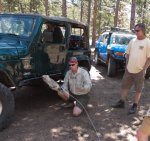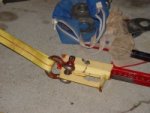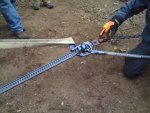This is Bill Burke about to use something "stretchy" in a winching exercise:
The 1st pic show Mr. Burke securing a "stretchy" strap to the side of a vehicle. The second pic shows Mr. Burke using on of those darn "stretchy" straps in a HiLift winching exercise. So this is wrong? Please explain. The 3rd pic is Mr Elfstrom of Overland Experts using a "stretchy" strap in a HiLift winching excersice. He is wrong as well? Both of these men are tops in their field. I think we can agree on that can't we.
Maybe I'm just mis-understanding you but you did say it was not good to use straps in any winching exercise didn't you. If not, I apologize.
"...I'm just a middle-aged dude who would hardly recognise a winch if he saw it" You said it, not me. And for God's Sake, don't let "spencyg" know this. He thinks your the bee's knees!
The 1st pic show Mr. Burke securing a "stretchy" strap to the side of a vehicle. The second pic shows Mr. Burke using on of those darn "stretchy" straps in a HiLift winching exercise. So this is wrong? Please explain. The 3rd pic is Mr Elfstrom of Overland Experts using a "stretchy" strap in a HiLift winching excersice. He is wrong as well? Both of these men are tops in their field. I think we can agree on that can't we.
Maybe I'm just mis-understanding you but you did say it was not good to use straps in any winching exercise didn't you. If not, I apologize.
"...I'm just a middle-aged dude who would hardly recognise a winch if he saw it" You said it, not me. And for God's Sake, don't let "spencyg" know this. He thinks your the bee's knees!



